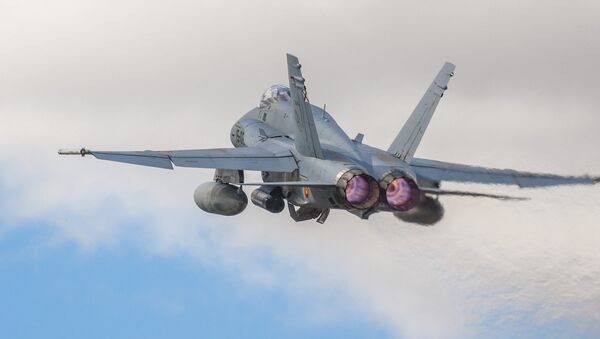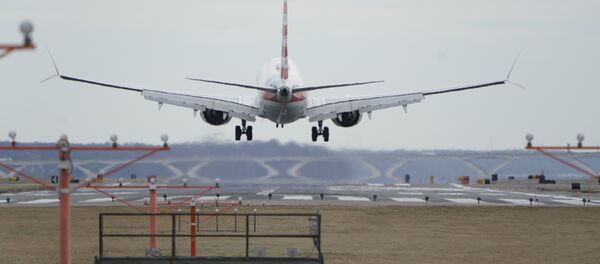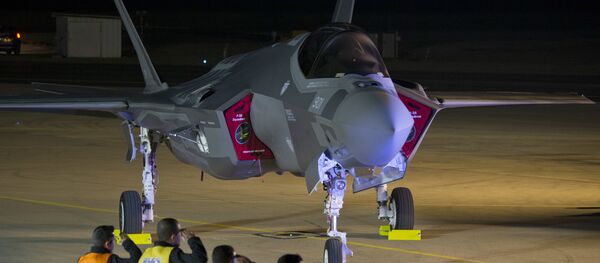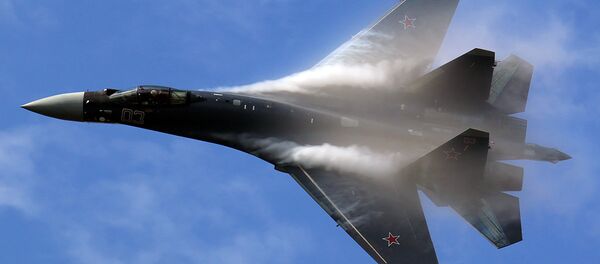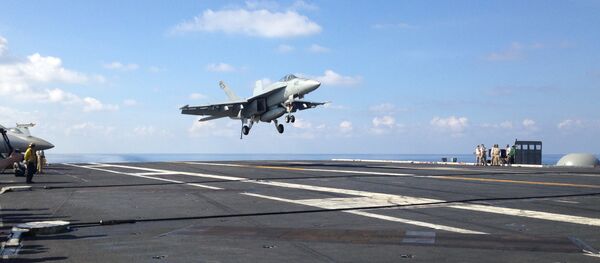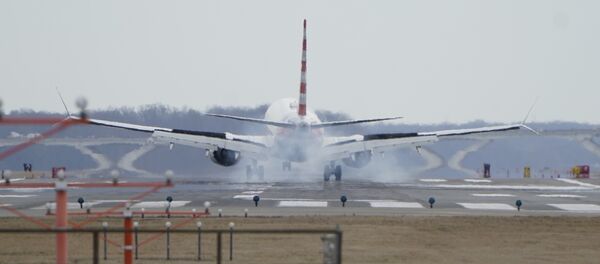Boeing’s F/A-18 Block III Super Hornet multi-role strike fighter jet comes in two versions — the single-seat E model and the two-seat F model, according to the company’s website. Sputnik has discussed the issue with Abraham Ait, the chief editor of Military Watch Magazine.
Sputnik: Recently, Boeing received a three-year contract worth $ 4 billion to upgrade F/A-18 Super Hornet Block II fighter bomber. Experts say that the Pentagon has long planned to replace the F/A-18 with Lockheed Martin’s F-35 Lightning II fighter-bombers. In your opinion, why did Boeing win this tender again?
Abraham Ait: It is critical when assessing the U.S. Navy’s modernization of its carrier based combat aircraft to understand the complementary roles allocated to various platforms — namely that between lighter shorter ranged aircraft oriented towards a strike role and heavier platforms designed for air superiority.
For the latter role however the U.S. Navy was unable to induct a fifth generation air superiority fighter capable of deploying from its carriers, largely due to budget cuts which ensued following the Cold War’s end, and the service thus invested in acquiring a modernized fourth generation aircraft — leading to the F-18E’s induction into service in 1999.
With the absence of an air superiority capable fifth generation carrier based fighter, it is vital for the U.S. Navy to modernise the F-18E alongside parallel induction of new F-35Cs.
Induction of high end fifth generation air superiority fighters by China and Russia into service from 2017 has been directly cited as an impetus to ensure that the F-18E remains cutting edge, and this has been highly beneficial for Boeing which has won a great deal of support for its F-18E Block III ‘4+ generation fighter’ program.
This has involved equipping the Super Hornet for next generation combat, which alongside considerable life extension includes deep structural and sensor upgrades, new electronic warfare systems, additional conformal fuel tanks, new mission computers and data links, and a new multi-function cockpit display.
Boeing won the tender for the Super Hornet upgrade likely as a result of the unique and highly cost-effective nature of its offer. The company has in the past demonstrated its ability to upgrade Cold War era platforms to a high ‘4+ generation’ standard, and perhaps best demonstrated by the highly successful F-15SG, F-15SA and F-15QA programs based on an airframe dating back in its service to 1976.
The Super Hornet remains considerably cheaper to operate and easier to maintain than the F-35C or other stealth aircraft, and while the price of the upgrade at $51 million per fighter (upgrading 78 jets for $4 billion) is high, it remains far more cost effective than alternative options other than abandonment of the F-35C’s carrier-based complement to obsolescence.
Sputnik: According to a report from Politico acting Defence Secretary Patrick Shanahan, during Defence Department meetings, disparaged Lockheed Martin in favor of Boeing. How do you assess the level of monopolization of the market by Boeing?
Abraham Ait: Defence Secretary Shanahan’s career of over thirty years at Boeing led to serious concerns begin raised that he may favor this supplier over others.
The Air Force’s recently released plans to acquire 80 F-15EX air superiority fighters in particular, a platform in which it had previously shown relatively little interest, exacerbated these concerns.
However, objectively speaking, Shanahan’s statements criticizing Lockheed Martin are far from unique — in particularly his criticisms of the F-35 program which was previously described by Senate Armed Services Committee Chairman John McCain as ‘a textbook example’ of the country’s ‘broken defense acquisition system.’
Boeing has arguably done a far better job in offering weapons platforms well suited to responding to emerging threats faced by the U.S. Military.
The proliferation of high end Russian air superiority fighters such as the Su-35 and Su-30 for example, which retained a number of key advantages over the F-35 in their air to air combat capabilities such as speed, range, missile carriage and operational altitude, meant that the F-15EX was a much welcome addition to the American arsenal. The same can be said of the F-18E Block III, both of which can play a complementary role to the F-35 on land and at sea.
The MQ-25 unmanned carrier based stealth tanker is another key example, and has been much sought after by the Navy as an ideal response to both the growing threats to conventional tankers posed by extreme range China and Russian air to air missiles (PL-XX and R-37 in particular), and these states’ growing maritime anti access area denial capabilities which force carrier air wings to operate at greater ranges from their targets.
Boeing’s position in the American arms market is far from that of a monopoly. Companies supplying the U.S. military can be better described as an oligopoly, of which Lockheed Martin is the largest and has continued to receive the bulk of contracts.
This was largely a result of Lockheed being awarded the leading role in manufacturing the F-35 fighter jet – by far the largest weapons program in military history.
Whether the disparity between the two manufacturers will change in future, particularly given the dissatisfaction repeatedly voiced by both government and military officials regarding their handling of the F-35 program, remains to be seen — but it could well lead to Boeing taking a greater market share.
Such a development would hardly be unprecedented should problems with the F-35 persist. A similar line of events occurred in the mid 1990s when Northrop Grumman’s poor management of the B-2 Spirit stealth bomber program played a major role in it being denied contracts for future high end combat aircraft programs such as the YF-23 air superiority fighter.
While there is a potential for a conflict of interests, Defence Secretary Shanahan’s statements regarding Boeing’s efficiency in fulfilling contracts relative to Lockheed Martin appears to be well founded.
The latter has cost the US military tens of billions of dollars due to its mismanagement of the F-35 program, and its management of the F-22 program for which it was also prime contractor was also far from ideal with extreme operational costs and maintenance requirements far greater than those initially envisioned.
This demonstrates the company’s confidence that it can deliver high end weapons systems within budget, eliminating financial risk for the US Air Force.
Sputnik: In 2018 Boeing won several billion dollars’ worth of contracts with the US Air Force: a $9.2 billion contract to produce the US Air Force’s next-generation training jet, an $805 million contract to build the US Navy’s first four MQ-25 unmanned tankers, and a contract worth up to $2.38 billion to manufacture a replacement for the USAF’s Huey helicopter. How will the recent technical and safety-related problems affect cooperation with the US Air Force this year?
Abraham Ait: It is critical when assessing technical and safety issues in Boeing’s products to recognize the separation between the two largest divisions of the Boeing Company, which are Boeing Commercial Airplanes and Boeing Defence, Space & Security.
While issues have emerged recently regarding the safety of the 737 civilian airliner manufactured by the former, this does not necessarily imply potential performance issues with the latter’s products.
Cooperation with the US Military is unlikely to be affected despite recent drama surrounding the 737, and cooperation with the Air Force in particular is likely to expand as the service comes to commission its first major frontline fighter from Boeing in several years in the form of the F-15EX.
By demonstrating it can be a highly reliable partner, in contrast to recent reports regarding Lockheed Martin’s often uncompromising positions in contract negotiations with the Air Force, Boeing can better position itself to win much valued trust and a working relationship which will provide it with a key advantage when bidding for future contracts with the US Military.
Views and opinions expressed in this article are those of Abraham Ait and do not necessarily reflect those of Sputnik.

